Arvid Harnack
Arvid Harnack (German: [ˈaʁ.vɪt ˈhaʁ.nak] (![]() listen); 24 May 1901 in Darmstadt – 22 December 1942 in Berlin) was a German jurist, Marxist economist, Communist[1] and German resistance fighter in Nazi Germany.[2] Harnack became a leading German resistance fighter as a member of a Berlin anti-fascist resistance group that was later called the Red Orchestra (Rote Kapelle) by the Abwehr. He and his American-born wife, Mildred Harnack, were executed by the Nazi regime during WWII.
listen); 24 May 1901 in Darmstadt – 22 December 1942 in Berlin) was a German jurist, Marxist economist, Communist[1] and German resistance fighter in Nazi Germany.[2] Harnack became a leading German resistance fighter as a member of a Berlin anti-fascist resistance group that was later called the Red Orchestra (Rote Kapelle) by the Abwehr. He and his American-born wife, Mildred Harnack, were executed by the Nazi regime during WWII.
Arvid Harnack | |
|---|---|
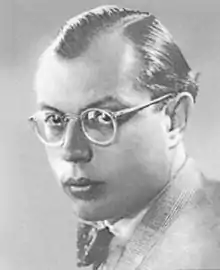 Arvid Harnack as a young man | |
| Born | 24 May 1901 |
| Died | 22 December 1942 (aged 41) |
| Nationality | German |
| Education | Friedrich Schiller University London School of Economics University of Wisconsin University of Giessen |
| Known for | Member of the Red Orchestra ("Rote Kapelle") |
Like numerous groups in other parts of the world, the undercover political factions led by Arvid Harnack and Harro Schulze-Boysen later developed into espionage networks.[3]
Life
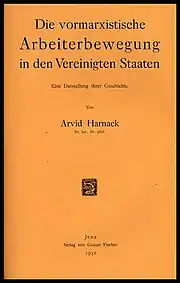
Harnack's family were prominent and academically gifted Protestant Germans from the Baltic region.[4] His father was literary history professor Otto Harnack[5] and his mother was Clara Harnack née Reichau,[6] an artist. Reichau was the granddaughter of Justus von Liebig, one of the principal founders of organic chemistry.[7] Harnack's siblings were Falk Harnack, his elder brother, Inge Harnack and Angela Harnack, a violin teacher. Harnack was the nephew of theologian Adolf von Harnack.[8]
In 1919 he became a member of the Freikorps, a volunteer militia.[9] From 1919 to 1923 he studied law at the Friedrich Schiller University), Graz, and Hamburg and became a Doctor of Law in 1924.[9] He completed postgraduate studies in economics at Hamburg and the London School of Economics before being awarded a Rockefeller scholarship to study at University of Wisconsin.[10]
In 1926, Harnack met American literary historian Mildred Fish, also a student at Wisconsin University, after Harnack wandered into the wrong hall.[11] After a brief friendship and love affair, they married on 7 August 1926.[12] In March 1928, at the end of the semester, Harnack returned to Germany as his fellowship had ended[13] while Mildred stayed for another year to complete her studies. On June 2, 1929, Mildred Harnack moved to Germany. In 1929, the couple were living in the small university towns of Jenna and Giessen.[14] In 1931, Harnack was promoted to his 2nd doctorate, a Doctor of Philosophy at University of Giessen with a thesis titled: Die vormarxistische Arbeiterbewegung in den Vereinigten Staaten ("The Pre-Marxist Workers' Movement in the United States")[9] that dealt explicitly with the history of the American worker's movement.[15] The thesis was sponsored by Friedrich Lenz, who founded the Giessen School of National Economics.[16]
The Harnacks, like many of their counterparts, shared an interest in the Soviet Union.[17] They decided to set up a study group in the autumn of 1931, [17] along with Friedrich Lenz.[16] At the height of the Great Depression, Harnack's hope was that Germany could serve as a spiritual and economic bridge between East and West.[9] Lenz believed that only an alliance with the Soviet Union would relieve Germany of the constraints of the Treaty of Versailles and re-establish the country's position and return it to great nation status.[16]
ARPLAN
Harnack founded the Wissenschaftliche Arbeitsgemeinschaft zum Studium der sowjetischen Planwirtschaft ("Scientific Working Community for the Study of the Soviet Planned Economy"), or ARPLAN in 1931.[18] This was an organisation of writers and academics that met once a month to discuss the Soviet planned economy.[19] Harnack became Secretary of the group and Lenz became the President.[19] The first meeting of the group took place on 3 and 4 January 1932.[19] The study group had around 50 members. Among them was the leading Soviet economist and diplomat Sergei Bessonov, who at the time was a member of the Russian trade delegation[19] and Alexander Hirschfeld who was Harnack's contact at the Soviet embassy in Berlin.[20] At the time, the Harnack's were also members of the Association of Intellectual Workers (Bund der Geistesarbeiter), also a communist front organisation.[21] They were seen by Moscow as places that could recruit 'people of good will or people of influence but not necessarily party member's.[21] According to Georgi Dimitrov, the head of Communist International, they were organisation's that enabled them to extend their influence to people that were difficult to reach. Communist or KPD members would stay in the background, in meetings that were open to all, but orientate the discussion to gain influence. [21] The real purpose of organisations like ARPLAN was to draw people of influence who supported a pro-Soviet agenda in relation to German policy.[21] Bessonov was under instruction to recruit suitable German technocrats for visits to the Soviet Union and extract useful information for the Soviet trade legation.[22]
In January 1932, Mildred lost her position teaching English and the couple had to move to 61 Hasenheide in Neukölln.[23] A three-week study trip encompassing the period from 20 August to 12 September 1932 to the Soviet Union was organized with the help of Bessonov and the Soviet embassy, for twenty-three members of ARPLAN[24] The Soviet economy was observed in Moscow, Leningrad, Odesa, Kiew, and in the Dnieper region.[25] [26] There have been allegations that Harnack was recruited by Soviet intelligence, during the trip.[25] In David Dallins, Soviet Espionage [27] he describes the trip as the turning point in Harnack's life.[25] He was asked bluntly by senior Comintern leaders to spy for the Soviet Union and Harnack consented.[25] This allegation was again repeated in 1994 by KGB Deputy Director Pavel Sudoplatov.[24] although it was not recorded in Harnack's own records.[28] Even though the group travelled through Ukraine and as academics, many of the group took notes, including Harnack, the group failed to notice the vast famine that was unfolding in front of them.[25] When Arthur Koestler made the same trip at the same time, he documented a ragged army of starving people in almost every station.[29] Koestler believed that the Harnacks' mentality was driven by the fact that they knew that the propaganda effect put on by the Soviets existed, and that although they knew the standard of living in the west was much higher than the Soviet Union, they judged that Soviet citizens were much better off under Stalin than they were under the Czar.[29]
By the end of 1932, a scientific career was no longer an option for Harnack in his strictly planned economic orientation at the universities, which were now national socialist, and he was no longer eligible for the careers of the National Socialist. His thesis on "The Pre-Marxist Workers' Movement in the United States" could no longer be published.[30] In the same year he began delivering illegal training courses for former members of the Marxist Workers School (MASCH) and at the Berliner Abendgymnasium ("Berliner Städtische Abendgymnasium für Erwachsene"),[30] an evening high school for adults that taught a curriculum that was suitable for university admission.[31] while Mildred started teaching English literature also at the same school.[31]
After Hitler's rise to power and the Reichstag fire in early 1933, the Harnacks hastened to lower their profile. [32] They decided to dissolve ARPLAN the following month, March 1933.[32]
Brysac p.128 2000
Resistance
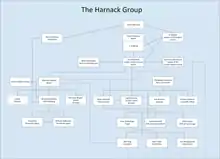
From 1933 Harnack was appointed as civil servant in the Reich Ministry of Economics (Reichswirtschaftsministerium), eventually achieving the rank of senior civil servant (Oberregierungsrat)[33] in the American referat.[34] The same year, he also finished his legal qualifications in Jena, successfully completing the junior law examination.
With the writer Adam Kuckhoff, and his wife, Greta, the Harnacks assembled a discussion circle which debated political perspectives on the time after the National Socialists' expected downfall or overthrow. p86 brysac
By 1935, Harnack was active as a lecturer on foreign policy at the University of Berlin.
Beginning in 1937, Harnack agreed with Donald Heath, the First Secretary at the US Embassy, to inform the US about Hitler's preparations for war. In 1941, after the Americans left Berlin, Harnack was contacted by the Soviets and he agreed to supply them with information as well. Unbeknownst to him, they applied the code names Balte and Corsican to him. While Harnack's relations with the Americans had been based on a mutual friendship with Heath, his relation with the Soviets was reluctant, as he didn't trust Stalin.
In 26 January 1937, a new civil service law gave Nazi officials the power to sack tenured civil servants.[35] Walther Funk, the manager of Harnack's, persuaded him to join the Nazi party to protect himself, to become what was known as a Hamburger, i.e. Nazi brown outside, Moscow red inside.[1] In May 1937, Harnack joined the Nazi party with number: 4153569.[1]
Harnack/Schulze-Boysen Group
On 8 August 1935, three months after Harnack joined the trade ministry, he met with the first secretary of the Soviet Embassy in Berlin, Alexander Hirschfeld in a meeting that lasted three hours.[36] During the meeting, Hirschfeld informed Harnack that his position in the trade ministry could provide useful information that could be used to defeat the Nazis, and offered to establish a system to convey the documents to Moscow.[37] Harnack agreed to be a informer[36] and was give the codename Balt, assigned a control officer, Alexander Belkin[36] and assigned a mission to increase his sources by building a network of contacts.[38] However, Hirschfeld requested that Harnack break of all relation's with the KPD and to avoid working for the resistance,[36] but he decided not to comply[37] Harnack was never interested in becoming a Soviet agent, he considered himself a communist and would supply information to anybody who would take part in anti-fascist operations that helped to destroy the Nazi's[38] According to KGB sources, between 1935 and 1938 Harnack supplied information relating to the German currency, German investments abroad and details of the German foreign debt. Harnack also provided details of secret trade agreements to Soviet intelligence.[39] During that period, Harnack circulated the same information to other groups.[37]
In 1935, Harnack had his first contact with the fervent anti-nazi Harro Schulze-Boysen,[38] however due to their different temperaments, Harnack decided not to meet again.[38]
Hans Coppi, as well as with a leading Social Democrat Adolf Grimme.[39]
In 1940, with th young and active Communist Hilde Coppi
In 1940, Harnack had access to other resistance groups and began to cooperate with them. The most important of these was a group run by Harro Schulze-Boysen, a Luftwaffe lieutenant and descendant of an old German military family. who had known Harnack since 1935,[40] but was reintroduced to him sometime in late 1939 or early 1940 through Greta Kuckhoff.[41] The Kuckhoffs had known the Schulz-Boysen's since 1938 and started to engage them socially in late 1939 or early 1940 by bringing Mildred and Libertas together while on holiday in Saxony.
On the 17 September 1940, Arvid and Mildred met the third secretary member of the Soviet embassy, Alexander Korotkow who used the alias Alexander Erdberg[42] while meeting the couple in their Tiergarten apartment.[34] Korotkov was a Soviet intelligence agent who had been operating clandestinely in Europe for much of the 1930s as an employee of the foreign intelligence service of the Soviet People's Commissariat for State Security (NKGB) but had been dismissed during Stalin's purges, but managed to work back into the service via help from his friend Lavrentiy Beria.[42] Initially wary and suspicious of the uninvited guest, Erdberg proposed to Harnack a second meeting at the Soviet Embassy in Berlin, where Erdberg could verify his bona fides[34] and prove to Harnack that he was not a decoy. Erdberg finally convinced Harnack, who was reluctant to agree.[43] Several reasons have been advanced as to why Harnack decided to become a spy, including a need for money, being ideologically driven, and possibly blackmail by Russian intelligence. It was known that Harnack had planned an independent existence for his friends. According to a statement by Erdberg discovered after the war, he thought Harnack was not motived by money nor ideologically driven but that he was specifically building an anti-fascist organisation for Germany, as opposed to an espionage network for Russian intelligence. He considered himself a German patriot.[43]
The resulting network was far-reaching and didn't have a name. After the arrests, the Abwehr labeled them Red Orchestra (Rote Kapelle). In the Gestapo's terms, a spy hitting Morse codes was a pianist, a group of pianists formed an orchestra, and, as Communists, they were red. In reality, the resistance group had members from all walks of life. Membership included men and women from all social classes and age groups, and also from varied religious ideologies, mainly communist and National Bolshevik, and Jews and Christians.
In 1941, Harnack sent the Soviets information about the forthcoming invasion. That same year, he published the resistance magazine, Die innere Front ("The Inner Front"). At about the same time, he received information from Rudolf von Scheliha about the Final Solution.
Trial and death
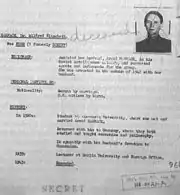
In 1941, through a Soviet military blunder, addresses of members of the group were transmitted across Europe when the Soviets attempted to re-connect with the resisters. A year later, in July 1942, the Decryption Department of the Oberkommando des Heeres managed to decode the group's radio messages, and the Gestapo pounced. On 7 September, Arvid and Mildred Harnack were arrested. Arvid Harnack was sentenced to death on 19 December after a four-day trial before the Reichskriegsgericht ("Reich Military Tribunal"), and was put to death three days later at Plötzensee Prison in Berlin. He and his co-conspirators were hanged from meat hooks by thin ropes, a method designed to prolong their suffering. Mildred Harnack was originally sentenced to six years in prison, but Hitler swiftly cancelled the sentence and ordered a new trial, which pronounced the desired death sentence. She was beheaded by guillotine. The Harnacks' bodies were released to Hermann Stieve, anatomy professor at Humboldt University, to be dissected for research. A cenotaph was installed for them after the war by Arvid's brother Falk Harnack, a member of the White Rose resistance group, at Zehlendorf Cemetery.
Awards and honours
- On 6 October 1969, Harnack was posthumously awarded the Order of the Red Banner.[44]
- In Magdeburg, a street called Harnackstraße is named after him and Mildred, as well as similar named streets in the Lichtenberg, Berlin[45] and Reudnitz in Leipzig.
- In Jena a street known as the Arvid-Harnack-Straße, is named after him.
- In the courtyard location at Unter den Linden 6 of the Humboldt University of Berlin, there is a memorial stone.
- In Neukölln area of Berlin, in the Hasenheide, corner of Lilienthalstraße, a plaque commemorates the Harnack's and their roommate Stefan Heym.
Gallery
_1964%252C_MiNr_1019.jpg.webp) A Commemorative stamp honouring Mildred Harnack and her husband Arvid that was issued by the Deutsche Post of the GDR in 1964
A Commemorative stamp honouring Mildred Harnack and her husband Arvid that was issued by the Deutsche Post of the GDR in 1964 A Commemorative stamp honouring Arvid Harnack, Harro Schulze-Boysen and John Sieg, from the GDR, 1983
A Commemorative stamp honouring Arvid Harnack, Harro Schulze-Boysen and John Sieg, from the GDR, 1983_Mildred_Harnack-Fish.jpg.webp) Commemorative plaque at the Peter A. Silbermann School/Friedrich Ebert Secondary School in Berlin-Wilmersdorf
Commemorative plaque at the Peter A. Silbermann School/Friedrich Ebert Secondary School in Berlin-Wilmersdorf Memorial plaque for Arvid and Mildred Harnack at the Berlin building where they lived, 61 Hasenheide, Neukölln
Memorial plaque for Arvid and Mildred Harnack at the Berlin building where they lived, 61 Hasenheide, Neukölln_Opfer_des_Faschismus.jpg.webp) Memorial stone, "NS-Opfer" by Johanna Jura erected in 1976 at 6 Unter den Linden in Mitte
Memorial stone, "NS-Opfer" by Johanna Jura erected in 1976 at 6 Unter den Linden in Mitte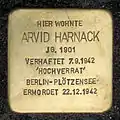 A Stolperstein for Arvid Harnack at 14 Genthiner Straße at Tiergarten
A Stolperstein for Arvid Harnack at 14 Genthiner Straße at Tiergarten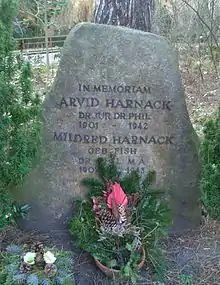 Memorial stone to Arvid and Mildred Harnack at Friedhof Zehlendorf cemetery at 33 Onkel-Tom-Straße, Berlin-Zehlendorf
Memorial stone to Arvid and Mildred Harnack at Friedhof Zehlendorf cemetery at 33 Onkel-Tom-Straße, Berlin-Zehlendorf
Literature
- Beier, Gerhard (1984). Arbeiterbewegung in Hessen : zur Geschichte der hessischen Arbeiterbewegung durch einhundertfünfzig Jahre (1834-1984). Die Hessen-Bibliothek (in German) (1st ed.). Frankfurt am Main: Insel. p. 438. ISBN 9783458142133. OCLC 1070118387.
- Brysac, Shareen Blair (2003). Mildred Harnack und die Rote Kapelle : die Geschichte einer ungewöhnlichen Frau und einer Widerstandsbewegung (in German) (1st ed.). Bern: Scherz. ISBN 9783502180906. OCLC 884470848.
- Dodd, Martha (2005). Meine Jahre in Deutschland 1933 - 1937 nice to meet you, Mr. Hitler! (in German). Frankfurt am Main: Eichborn. ISBN 9783821807621.
- Lenz, Friedrich (1948). Wirtschaftsplanung. Der Deutschenspiegel, 34/35 (in German). Stuttgart: Deutsche Verl.-Anst. OCLC 250536049.
- Kuckhoff, Greta (1986). Vom Rosenkranz zur Roten Kapelle e. Lebensbericht (in German) (7th ed.). Berlin: Verlag Neues Leben. OCLC 74777195.
- Roloff, Stefan; Vigl, Mario (2004). Die Rote Kapelle : die Widerstandsgruppe im Dritten Reich und die Geschichte Helmut Roloffs [The Red Orchestra: the resistance group in the Third Reich and the history of Helmut Roloff] (in German) (1st ed.). Berlin: Ullstein Verlag. ISBN 3-548-36669-4. OCLC 1100264932.
- Rosiejka, Gert (1985). Die Rote Kapelle : "Landesverrat" als antifaschist. Widerstand [The Red Orchestra: "treason" as anti-fascist. resistance] (in German) (1. Aufl ed.). Hamburg: Ergebnisse-Verl. ISBN 978-3-925622-16-8.
- Scheel, Heinrich (1994). "Die Rote Kapelle – Widerstand, Verfolgung, Haft". In Coppi, Hans Jr; Danyel, Jürgen; Tuchel, Johannes (eds.). Die Rote Kapelle im Widerstand gegen Hitler. Berlin: Rütten & Loenig. ISBN 3-89468-110-1.
References
- Brysac 2000, p. 195.
- "Arvid Harnack". Gedenkstätte Deutscher Widerstand. German Resistance Memorial Center. Retrieved 24 December 2019.
- Kesaris, Paul. L, ed. (1979). The Rote Kapelle: the CIA's history of Soviet intelligence and espionage networks in Western Europe, 1936-1945. Washington DC: University Publications of America. p. 140. ISBN 0-89093-203-4.
- Brysac 2000, p. 73.
- "Harnack, Arvid". Gazetteer Hess (in German). Hessisches Landesamt für geschichtliche Landeskunde. 23 October 2020. Retrieved 14 January 2021.
- Brysac 2000, p. 74.
- Royal Society of London (1 January 1875). "Obituary Notices of Fellows Deceased". Proceedings of the Royal Society of London. 24: xxvii–xxxvii. Retrieved 18 January 2021.
- David J. Dallin (1955). Soviet Espionage. Yale University Press. p. 234. ISBN 9780598413499. Retrieved 27 December 2019.
- Eckelmann, Susanne (14 September 2014). "Arvid Harnack 1901-1942". 20 JAHRE LEMO. Berlin: Deutsches Historisches Museum. Retrieved 31 December 2019.
- Brysac 2000, p. 52.
- Nelson 2009, p. 10.
- Brysac 2000, p. 55.
- Brysac 2000, p. 64.
- Nelson 2009, p. 26.
- Ihde, Jenifer (2001). "PART II. 1929 - 1943: Germany. 1920s & 1930s. a passion for the literary". Honoring Mildred Harnack. Memorial Library University of Wisconsin-Madison. Retrieved 31 January 2021.
- Petrescu 2010, p. 193.
- Nelson 2009, p. 48.
- Petrescu 2010, pp. 192-193.
- Shareen Blair Brysac (2000). Resisting Hitler: Mildred Harnack and the Red Orchestra. Oxford University Press. p. 107. ISBN 978-0-19-992388-5. Retrieved 14 January 2021.
- Brysac 2000, p. 107.
- Brysac 2000, p. 108.
- Nelson, Anne (2009). Red Orchestra. The Story of the Berlin Underground and the Circle of Friends Who Resisted Hitler. New York: Random House. p. 48. ISBN 978-1-4000-6000-9.
- Brysac 2000, p. 111.
- Brysac 2000, p. 117.
- Brysac 2000, p. 118.
- Jürgen, Danyel (1994). "Zwischen Nation und Sozialismus: Genese, Selbstverständnis und ordnungspolitische Vorstellungen der Widerstandsgruppe um Arvid Harnack und Harro Schulze- Boysen". In Steinbach, Peter; Tuchel, Johannes (eds.). Widerstand gegen den Nationalsozialismus. 323. Bonn: Bundeszentrale für politische Bildung. pp. 468–487.
- David J. Dallin (1955). Soviet Espionage. Yale University Press. p. 234. ISBN 9780598413499. Retrieved 27 December 2019.
- Nelson 2009, p. 50.
- Brysac 2000, p. 119.
- Tuchel, Johannes (October 1988). "Weltanschauliche Motivationen in der Harnack/Schulze-Boysen-Organisation: („Rote Kapelle")". Kirchliche Zeitgeschichte - Theologie und Politik (in German). Vandenhoeck & Ruprecht (GmbH & Co. KG). 1 (2): 267–292.
- Corina L. Petrescu (2010). Against All Odds: Models of Subversive Spaces in National Socialist Germany. Peter Lang. p. 195. ISBN 978-3-03911-845-8. Retrieved 31 January 2021.
- Nelson 2009, p. 57.
- Kambas, Chryssoula; Mitsou, Marilisa (15 July 2015). Die Okkupation Griechenlands im Zweiten Weltkrieg: Griechische und deutsche Erinnerungskultur (in German). Böhlau Verlag Köln Weimar. p. 205. ISBN 978-3-412-22467-7. Retrieved 22 January 2021.
- Ohler, Norman; Mohr, Tim; Yarbrough, Marshall (14 July 2020). The Bohemians : the lovers who led Germany's resistance against the Nazis. Boston: Houghton Mifflin Harcourt. p. 107. ISBN 9781328566232.
- Brysac 2000, p. 194.
- Brysac 2009, p. 196.
- Nelson 2009, p. 92.
- Nelson 2009, p. 93.
- Brysac 2009, p. 197.
- "Arvid Harnack". Gedenkstätte Deutscher Widerstand. German Resistance Memorial Center. Retrieved 4 January 2020.
- Donate, Claus (23 March 1973). "Aus den Lebenserinnerungen einer Widerstandskämpferin". 13 (in German). Zeit-Verlag Gerd Bucerius GmbH & Co. KG. Die Zeit. Retrieved 16 August 2020.
- Brysac, Shareen Blair (23 May 2002). Resisting Hitler: Mildred Harnack and the Red Orchestra. Oxford University Press. pp. 199–202. ISBN 978-0-19-992388-5. Retrieved 1 February 2021.
- Brysac, Shareen Blair (23 May 2002). Resisting Hitler: Mildred Harnack and the Red Orchestra. Oxford University Press. p. 228. ISBN 978-0-19-992388-5. Retrieved 1 February 2021.
- Brysac 2000, p. 388.
- "Harnackstraße". KAUPERTS (in German). ZEPTER&KRONE. Retrieved 2 January 2020.
Bibliography
- Brysac, Shareen Blair (23 May 2002). Resisting Hitler: Mildred Harnack and the Red Orchestra. Oxford University Press. ISBN 978-0-19-992388-5. Retrieved 26 December 2018.
- Brysac, Shareen Blair (2000). Resisting Hitler: Mildred Harnack and the Red Orchestra. New York: Oxford University Press. ISBN 978-0-19-513269-4.
- Nelson, Anne (2009). Red Orchestra. The Story of the Berlin Underground and the Circle of Friends Who Resisted Hitler. New York: Random House. ISBN 978-1-4000-6000-9.
- Petrescu, Corina L. (2010). Against All Odds: Models of Subversive Spaces in National Socialist Germany. Peter Lang. ISBN 978-3-03911-845-8. Retrieved 20 January 2021.
External links
| Wikimedia Commons has media related to Arvid Harnack. |
- Arvid Harnack in the German National Library catalogue
- Biographies and information